Posts for: MacEamonn
Jan 28, 2016 13:40:55 #
A few companies make hotshoe adapters that isolate a DSLR's flash ckts from the flash's firing Ckt.
I bought a Wein HSHSB and a Vello HSA-PVU from B&H, both of which reduce the firing voltage from the flash. The Wein is rated up to 400volts and the Vello up to 60volts. The Vello needs/uses a CR2032 battery to operate, the Wein is a passive device (no battery needed). Both units also give you a PC connector.
I bought a Wein HSHSB and a Vello HSA-PVU from B&H, both of which reduce the firing voltage from the flash. The Wein is rated up to 400volts and the Vello up to 60volts. The Vello needs/uses a CR2032 battery to operate, the Wein is a passive device (no battery needed). Both units also give you a PC connector.
Mar 21, 2014 18:34:18 #
I was trying to fix my old Canon FD 50mm 1.4 SSC lens and during disassembly of the breech-lock assembly the little return spring on the AE Lockout Pin grew little feet and ran away never to be seen again. I bought a "defective lens" from Robert's Camera in Indianapolis Indiana, but it was such a nice lens, other than the stuck aperture blades, I took it apart and fixed it. Now I still don't have a spring. Looking at my AE1 Program it looks to me like the spring in the lens may be either redundant or meant for if the lens was used on a different series of camera.
Is anyone familiar with this?
Is anyone familiar with this?
Mar 21, 2014 18:26:26 #
Here's a couple resources for anyone who is trying to keep their old film cameras going on their own.
Videos on youtube: Fix Old Cameras Channel: http://www.youtube.com/channel/UC_LLC4wtg7fORCFtw97xhDg
How to disassemble an old style Canon FD lens (1.4 SSC): http://rick_oleson.tripod.com/index-161.html
Videos on youtube: Fix Old Cameras Channel: http://www.youtube.com/channel/UC_LLC4wtg7fORCFtw97xhDg
How to disassemble an old style Canon FD lens (1.4 SSC): http://rick_oleson.tripod.com/index-161.html
Mar 4, 2014 16:39:34 #
rpavich wrote:
Shouldn't it be correct right out of the box?
You'd think so, but I guess they make them calibrate-able just in case they're not.
Mar 3, 2014 14:04:18 #
rpavich wrote:
Something is screwy here...hmm...
The incident light meter should give you a correctly exposed photo no matter what the color of the subject...
I saw that you said it was "lying" to you...is there some calibration issue?
Is a factory reset in order or something? This doesn't sound normal.
It shouldn't be a stop off under normal conditions.
The incident light meter should give you a correctly exposed photo no matter what the color of the subject...
I saw that you said it was "lying" to you...is there some calibration issue?
Is a factory reset in order or something? This doesn't sound normal.
It shouldn't be a stop off under normal conditions.
I followed the instructions for the lightmeter and adjusted the calibration 1 EV/Stop (can't remember which way but I got it right the first time) and it seems like the meter is closer than it was (Just taking an incidence reading in the middle of my yard was indicating an EV of 16 with the meter set to ASA/ISO 125. Everything I read says that it should have calculated an EV-15 [cloudless day at noon}).
Mar 3, 2014 11:50:52 #
mcveed wrote:
Are you sure you aren't taking reflective readings with the dome on? That will underexpose you by 2 or 3 stops.
Doing both types of readings and both readings with the factory calibration on the Lightmeter the EV readings are high and result in the suggested f/stops causing pictures to be underexposed.
Mar 2, 2014 14:52:56 #
I played with the EOS60D and my light meter again today around noon (same conditions as yesterday: sunny, no clouds).
I realized that my lightmeter had been lying yesterday (it apparently "thought" the light was one EV/stop different than it really was, it was reading EV16 on a "sunny day" with the ASA/ISO set to 125 when it should have been reading EV15. When I compensated for that in its calibration function it decided my truck was an f/11 @ 1/125 with ISO at 125.
I shot a picture with the 60D at those settings (see IMG_0063copy.jpg) and that is definitely in the ball park.
I then set the Exposure Compensation in the 60D's control panel to -2/3s EV (also tried -1EV) and the Camera started agreeing with the light meter (See IMG_0067copy.jpg which the camera selected f/11 in Shutter Priority mode, shutter @ 1/125 and ASA/ISO at 125). PS: I also turned off the auto light compensation for this picture.
Just for fun with I took a picture of greenery (once again in Shutter Priority mode, 1/125, ASA/ISO 125, -2/3EV and the Camera chose f/10) That picture appears to be in the ball park also (IMG_0068copy.jpg)
I was reading a dissertation online that said none of the Camera Manufacturers seem to agree on calibration standards for their metering in their cameras. Based on the fact that my old Canon AE-1 Program's meter was agreeing with the EOS60D's meter (before I added compensation) I'd say Canon's metering algorithms tend to lean toward about a stop of overexposure in natural light. Has anyone else found that to be true?
I realized that my lightmeter had been lying yesterday (it apparently "thought" the light was one EV/stop different than it really was, it was reading EV16 on a "sunny day" with the ASA/ISO set to 125 when it should have been reading EV15. When I compensated for that in its calibration function it decided my truck was an f/11 @ 1/125 with ISO at 125.
I shot a picture with the 60D at those settings (see IMG_0063copy.jpg) and that is definitely in the ball park.
I then set the Exposure Compensation in the 60D's control panel to -2/3s EV (also tried -1EV) and the Camera started agreeing with the light meter (See IMG_0067copy.jpg which the camera selected f/11 in Shutter Priority mode, shutter @ 1/125 and ASA/ISO at 125). PS: I also turned off the auto light compensation for this picture.
Just for fun with I took a picture of greenery (once again in Shutter Priority mode, 1/125, ASA/ISO 125, -2/3EV and the Camera chose f/10) That picture appears to be in the ball park also (IMG_0068copy.jpg)
I was reading a dissertation online that said none of the Camera Manufacturers seem to agree on calibration standards for their metering in their cameras. Based on the fact that my old Canon AE-1 Program's meter was agreeing with the EOS60D's meter (before I added compensation) I'd say Canon's metering algorithms tend to lean toward about a stop of overexposure in natural light. Has anyone else found that to be true?
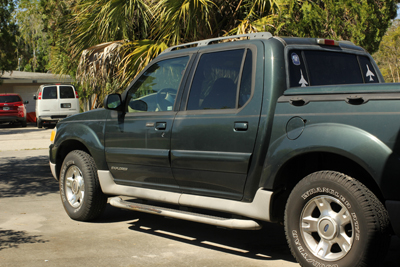
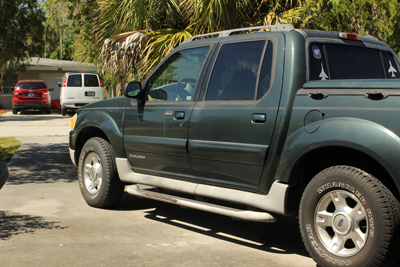
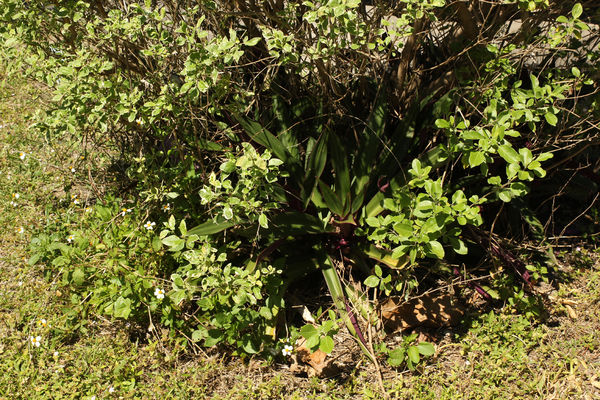
Mar 1, 2014 17:24:14 #
BigBear wrote:
I use my camera meter and tend to under expose and lighten in pp only if necessary. I prefer your 1st pic.
The truck is not that dark of a green in color. The second picture may be a touch (maybe a 1/2 stop) overexposed.
Mar 1, 2014 16:05:59 #
Using my "mark 1" eyeball the f/8 photo is closer to what it looked like (sitting in shade looking out at vehicle). I have always felt that the AE-1 Program's metering was maybe a 1/2 to 1stop too fast in bright sunlight, but not 2. Do you know of any dissertations on this subject or a ball park "rule of thumb"? With the DSLR I can just set up the camera to do the 3 shot bracketing (just wasting space on the sd card), but with a film camera (especially the old Kodaks using 620 you only get 8 shots per roll) I want to make everyone count :D )
I played with my grey card, but I may need to wait for another bright cloudless day and investigate with it a little more.
I played with my grey card, but I may need to wait for another bright cloudless day and investigate with it a little more.
Mar 1, 2014 13:39:59 #
:? Where am I going wrong with my thought process?
For this experiment I used my Gossen DigiSix2 handheld meter, my 1981 Canon AE-1 Program SLR with the Canon FD 50mm f/1.4 lens, my Canon EOS60D DSLR with the Canon EF 35mm f/2 IS USM Lens, a Lastolite EzyBalance calibration card (white on one side, 18% gray on the other), and my handy 1981 Kodak Master Photo Guide (Daylight Exposure Dial pg7).
Weather & time: noonish EDT, sunny w/no clouds
location: Cape Coral, Fl
Which as far as I can tell is EV-15 to 16 on the EV scale
Now according to my light meter and the Kodak Guide with ASA/ISO set to 125, shutter to 1/125, and f/stop at f/16 I should have gotten a properly exposed picture (Canon EOS 60D, manual mode, ISO 125, Shutter 1/125, f/16 see attached photo 001 copy.jpg). As you can see it appears to be underexposed
Same picture Shutter Priority, ISO 125, shutter @ 1/125, Camera selected f/8 for the aperture (attached photo 002 copy.jpg). This photo appears about right (maybe slightly over, but I noticed I accidentally got some of the truck in the shadows so camera might have been slightly fooled).
While I didn't have any film in the AE-1 Program I set it to ASA/ISO 125, Shutter Priority 1/125, and its meter set the f/stop to f/8 also.
So where am I going off track? Do I need to adjust all my calculations by 2 stops (even with my old Kodak bellows type cameras) from what the meter and the guide say? I can't believe two cameras over 30 years apart in age have the same defect (if it is a defect). Should I calibrate my light meter to match the cameras? :?
For this experiment I used my Gossen DigiSix2 handheld meter, my 1981 Canon AE-1 Program SLR with the Canon FD 50mm f/1.4 lens, my Canon EOS60D DSLR with the Canon EF 35mm f/2 IS USM Lens, a Lastolite EzyBalance calibration card (white on one side, 18% gray on the other), and my handy 1981 Kodak Master Photo Guide (Daylight Exposure Dial pg7).
Weather & time: noonish EDT, sunny w/no clouds
location: Cape Coral, Fl
Which as far as I can tell is EV-15 to 16 on the EV scale
Now according to my light meter and the Kodak Guide with ASA/ISO set to 125, shutter to 1/125, and f/stop at f/16 I should have gotten a properly exposed picture (Canon EOS 60D, manual mode, ISO 125, Shutter 1/125, f/16 see attached photo 001 copy.jpg). As you can see it appears to be underexposed
Same picture Shutter Priority, ISO 125, shutter @ 1/125, Camera selected f/8 for the aperture (attached photo 002 copy.jpg). This photo appears about right (maybe slightly over, but I noticed I accidentally got some of the truck in the shadows so camera might have been slightly fooled).
While I didn't have any film in the AE-1 Program I set it to ASA/ISO 125, Shutter Priority 1/125, and its meter set the f/stop to f/8 also.
So where am I going off track? Do I need to adjust all my calculations by 2 stops (even with my old Kodak bellows type cameras) from what the meter and the guide say? I can't believe two cameras over 30 years apart in age have the same defect (if it is a defect). Should I calibrate my light meter to match the cameras? :?
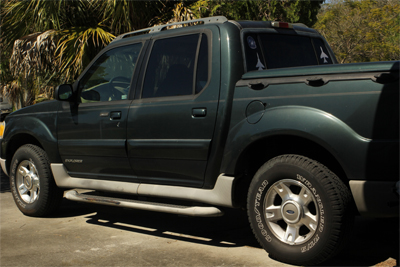
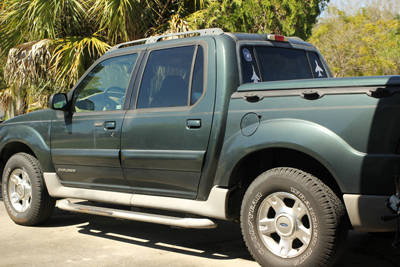
Feb 9, 2014 22:05:39 #
Thanks!!! As soon as my brain went into gear and I understood what you folks were talking about I realized I had something in my camera bag that would work, my old beat up Canon AE-1 Program focusing screen (long ago when I was young and stupid I tried to clean it, next thing I knew I was buying a new focusing screen, luckily the pack rat that I am kept the old one). While I had to "guestimate" the position of the thing in relation to the film path it was usable enough to tell me I hadn't quite reinstalled the lens' front focusing element where it belonged. Removed it and played with it starting to thread until I finally hit the spot that when it was fully screwed all the way in my reference points lined up again. Now the lens appears to focus at the marked distances again. Just for fun I found this on ebay: http://www.ebay.com/itm/230694932518?ssPageName=STRK:MEWNX:IT&_trksid=p3984.m1497.l2649 for $20.00 (2 1/4x3 1/4 Ground Glass) which is just the right size for 120 or 620 film cameras (I suspect that's on purpose :) )
Feb 9, 2014 17:46:23 #
Does anyone know or can point me to a source on how to confirm the focus adjustment range is correct on old Kodak Anastar manual focus lens mounted on various Kodak bellows cameras of the 40/50s era (Vigilants, Monitors, Tourist, Tourist II...) other than wasting rolls of film taking out of focus pictures? :?:
Jan 24, 2014 11:30:56 #
Why expose unexposed film? Moving 120 film onto a 620 film spool for use in a Camera that will only accept 620 film (in this case a Kodak Tourist II).
See attached photo taken with that camera in 1976
See attached photo taken with that camera in 1976
RA-5C Vigilante in afterburner on USS Forrestal
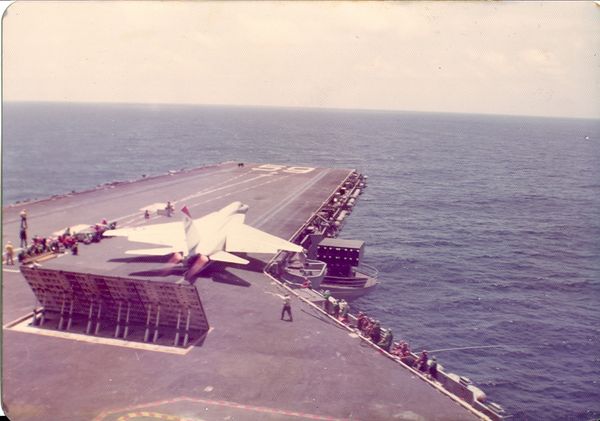
Jan 23, 2014 14:20:58 #
Question?
I know that florescent tubes "glow" for a little while after being turned off.
In a dark room lit by standard florescent work lighting when not in use, how long should the florescent lighting be off before exposing any unexposed film in that space? Is this something to be concerned with? :?:
I know that florescent tubes "glow" for a little while after being turned off.
In a dark room lit by standard florescent work lighting when not in use, how long should the florescent lighting be off before exposing any unexposed film in that space? Is this something to be concerned with? :?:
Dec 22, 2013 09:14:23 #
After reading the manual over a few times I think I finally deciphered what they are trying to tell me. Apparently by sending the correct series of manual aperture settings (each one followed by a full depress of the shutter button) will place the chip in one of three different program modes and then allow you to set the appropriate setting (via more manual aperture settings):
1) Maximum aperture of the lens
2) Focal length
3) Auto Focus "fine" adjust.
(I've attached a pdf from their website with the programing instructions for anyone who is interested)
1) Maximum aperture of the lens
2) Focal length
3) Auto Focus "fine" adjust.
(I've attached a pdf from their website with the programing instructions for anyone who is interested)